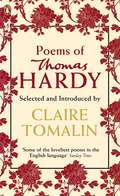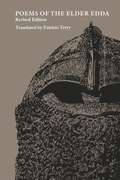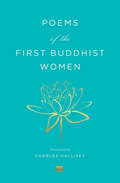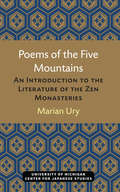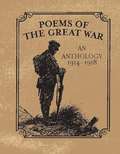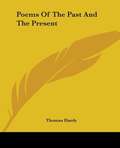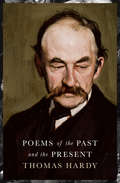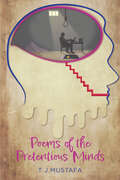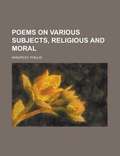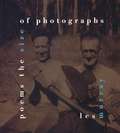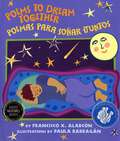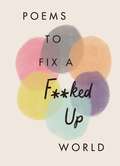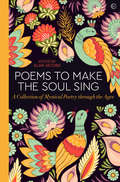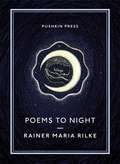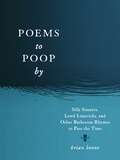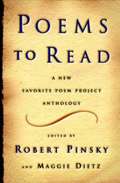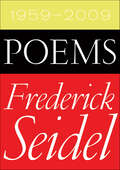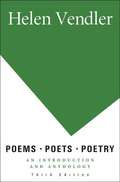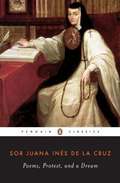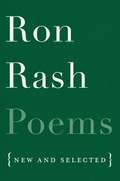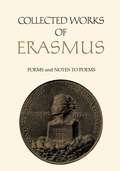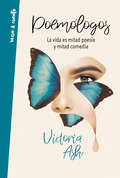- Table View
- List View
Poems of Thomas Hardy
by Thomas HardyThomas Hardy wrote some of the most moving and personal poems in his era and this collection brings together the best of his verse on life and love.Hardy's poems are by turn haunting, intense, songlike humerous and tender. From snatched lovers' meetings to the wreck of the Titanic from the death of a Dorest drummer boy in the Boer War to memories of his dead wife Emma, from ghosts, loss and longing to pleasure in landscape and weather, they tell the story of one of our best-loved writers, and the people and places that inspired him.
Poems of the Elder Edda
by Patricia Terry Charles W. DunnThe great poetic tradition of pre-Christian Scandinavia is known to us almost exclusively though the Poetic Edda. The poems originated in Iceland, Norway, and Greenland between the ninth and thirteenth centuries, when they were compiled in a unique manuscript known as the Codex Regius.The poems are primarily lyrical rather than narrative. Terry's readable translation includes the magnificent cosmological poem Völuspá ("The Sibyl's Prophecy"), didactic poems concerned with mythology and the everyday conduct of life, and heroic poems, of which an important group is concerned with the story of Sigurd and Brynhild.Poems of the Elder Edda will appeal to students of Old Norse, Icelandic, and Medieval literature, as well as to general readers of poetry.
Poems of the First Buddhist Women: A Translation of the Therigatha (Murty Classical Library Of India - Hup Ser. #3)
by Charles HalliseyThe Therīgāthā is one of the oldest surviving literatures by women, composed more than two millennia ago and originally collected as part of the Pali canon of Buddhist scripture. These poems were written by some of the first Buddhist women—therīs—honored for their religious achievements. Through imaginative verses about truth and freedom, the women recount their lives before ordination and their joy at attaining liberation from samsara. Poems of the First Buddhist Women offers startling insights into the experiences of women in ancient times that continue to resonate with modern readers. With a spare and elegant style, this powerful translation introduces us to a classic of world literature.
Poems of the Five Mountains: An Introduction to the Literature of the Zen Monasteries (Michigan Monograph Series in Japanese Studies #10)
by Marian UryThis second, revised edition of a pioneering volume, long out of print, presents translations of Japanese Zen poems on sorrow, old age, homesickness, the seasons, the ravages of time, solitude, the scenic beauty of the landscape of Japan, and monastic life. Composed by Japanese Zen monks who lived from the last quarter of the thirteenth century to the middle of the fifteenth century, these poems represent a portion of the best of the writing called in Japanese gozan bungaku, “literature of the five mountains.” “Five mountains” or “five monasteries” refers to the system by which the Zen monasteries were hierarchically ordered and governed. For the monks in the monasteries, poetry functioned as a means not only of expressing religious convictions and personal feelings but also of communicating with others in a civilized and courteous fashion. Effacing barriers of time and space, the practice of Chinese poetry also made it possible for Japanese authors to feel at one with their Chinese counterparts and the great poets of antiquity. This was a time when Zen as an institution was being established and contact with the Chinese mainland becoming increasingly frequent—ten of the sixteen poets represented here visited China. Marian Ury has provided a short but substantial introduction to the Chinese poetry of Japanese gozan monasteries, and her translations of the poetry are masterful. Poems of the Five Mountains is an important work for anyone interested in Japanese literature, Chinese literature, East Asian Religion, and Zen Buddhism.
Poems of the Great War: An Anthology 1914-1918 (RP Minis)
by Edited by Christopher NavratilWorld War I poetry collection arranged chronologically from 1914-1918 from a range of prominent poets, many killed in battle.
Poems of the Past and the Present
by Thomas HardyThis scarce antiquarian book is a facsimile reprint of the original. Due to its age, it may contain imperfections such as marks, notations, marginalia and flawed pages. Because we believe this work is culturally important, we have made it available as part of our commitment for protecting, preserving, and promoting the world's literature in affordable, high quality, modern editions that are true to the original work.
Poems of the Past and the Present (Collected Works Of Thomas Hardy)
by Thomas HardyThe second collection of poetry from the author of such classics as Tess of the D&’Urbervilles and Far from the Madding Crowd.Although well known for his novels, like Jude the Obscure, Thomas Hardy also wrote poetry throughout his life. Poems of the Past and the Present is Hardy&’s second volume of poetry, originally published in 1901. This wide-ranging collection is divided into five sections: War Poems, Poems of Pilgrimage, Miscellaneous Poems, Imitations, Etc., and Retrospect. It features some of Hardy&’s finest work, including &“At a Lunar Eclipse,&” &“The Darkling Thrush,&” &“The Ruined Maid,&” &“The Self Unseeing,&” &“The Well-Beloved,&” and &“Drummer Hodge&” (originally titled &“The Dead Drummer&”).
Poems of the Pretentious Minds
by Tj MustafaPoems of the Pretentious Minds features a wide array of self-indulgent, darkly comical but heart-wrenching poetry that covers many topics such as love, family, friendship, death, sex addiction, abuse, anxiety, depression, suicide, mental turmoil, the city of London, various other locations around the UK and the intricacies of the world itself. Some of the poems also explore the contradiction of humanity and how one can appreciate the minute things in life, whilst others delve deeper into the human condition and how our emotions can ultimately cloud our judgement. Later poems take a more autobiographical approach and instead focus on the poet himself, detailing his personality, conflicting emotions, life experiences, deep-rooted thoughts and his overall outlook of the world. Most of the poems have a sharply satirical edge to them, particularly the ones that focus on modern-day society as a whole, and real life events that have sparked mass debate and controversy.
Poems on the Underground
by Gerard Benson Judith Chernaik Cicely Herbert Gerard Benson, Judith Chernaik and Cicely HerbertThis wonderful new edition of Poems on the Underground is published to celebrate the 150th anniversary of the Underground in 2013. Here 230 poems old and new, romantic, comic and sublime explore such diverse topics as love, London, exile, families, dreams, war, music and the seasons, and feature poets from Sappho to Carol Ann Duffy and Wendy Cope, including Chaucer and Shakespeare, Milton, Blake and Shelley, Whitman and Dickinson, Yeats and Auden, Seamus Heaney and Derek Walcott and a host of younger poets. It includes a new foreword and over two dozen poems not included in previous anthologies.
Poems on various subjects, religious and moral
by Phillis WheatleyExcerpt: . . . years, by thee Recover'd, in due order rang'd we see: Thy pow'r the long-forgotten calls from night, That sweetly plays before the fancy's sight. Mneme in our nocturnal visions pours The ample treasure of her secret stores; Swift from above the wings her silent flight Through Phoebe's realms, fair regent of the night; And, in her pomp of images display'd, To the high-raptur'd poet gives her aid, Through the unbounded regions of the mind, Diffusing light celestial and refin'd. The heav'nly phantom paints the actions done By ev'ry tribe beneath the rolling sun. Mneme, enthron'd within the human breast, Has vice condemn'd, and ev'ry virtue blest. How sweet the sound when we her plaudit hear? Sweeter than music to the ravish'd ear, Sweeter than Maro's entertaining strains Resounding through the groves, and hills, and plains. But how is Mneme dreaded by the race, Who scorn her warnings and despise her grace? By her unveil'd each horrid crime appears, Her awful hand a cup of wormwood bears. Days, years mispent, O what a hell of woe Hers the worst tortures that our souls can know. Now eighteen years their destin'd course have run, In fast succession round the central sun. How did the follies of that period pass Unnotic'd, but behold them writ in brass In Recollection see them fresh return, And sure 'tis mine to be asham'd, and mourn. O Virtue, smiling in immortal green, Do thou exert thy pow'r, and change the scene; Be thine employ to guide my future days, And mine to pay the tribute of my praise. Of Recollection such the pow'r enthron'd In ev'ry breast, and thus her pow'r is own'd. The wretch, who dar'd the vengeance of the skies, At last awakes in horror and surprise, By her alarm'd, he sees impending fate, He howls in anguish, and repents too late. But O what peace, what. . . "
Poems the Size of Photographs
by Les MurrayBrief, that place in the yearwhen a blossoming pear treewith its sweet laundered scentreinhabits wooden roadsthat arch and diverge upinto electronic snow city. --"Brief, That Place in the Year"In Poems The Size of Photographs, Les Murray deftly maneuvers through familiar themes--the local terrain of the Australian people, politics, and landscape, as well as the terrain that is harder to render tangible: history, myth, and symbol. As if trying to find the fissure through which to crack open his subject matter, Murray has sharpened his form to an ideogrammatic brevity. Each snapshot-like poem in this volume develops before the reader's very eyes, as the initially observed object or moment in time changes meaning and grows in complexity and resonance line by line.
Poems to Dream Together: Poemas para soñar juntos
by Francisco X. AlarcónA bilingual collection of poetry by acclaimed Chicano poet Francisco X. Alarcón celebrating family, community, nature, and the positive power of dreams to shape our future.A young boy dreams that "all humans / and all living / beings / come together / as one big family / of the Earth." So begins this delightful bilingual collection of poems by Francisco X. Alarcón. As we travel through the boy's colorful universe, we learn about his family and community working together and caring for each other and the world in which they live. Neighbors help repair adobe homes. The boy and his family share old photographs, tend their garden, and pamper Mamá who "works day and night." Tribute is paid to those who toil in the fields, and to César Chávez. Most of all, we see how dreams can take many forms, from the fantastic imaginary ones that occur while we sleep to the realistic ones that guide our lives and give us inspiration for the endless possibilities of the future. Partly based on Alarcón's own dreams and family memories of growing up in Mexico and California, and vibrantly illustrated by Paula Barragán, these joyous, universal poems will inspire all readers to dream their own dreams for a better, compassionate, and loving world. "Close your eyes / and now get ready / to hop on a dream."
Poems to Fix a F**ked Up World
by Various PoetsSometimes it's hard to keep looking up at the stars when the gutter we're in seems so full of sh*t. But isn't that why we need poetry? Oscar Wilde wrote some of his best poetry when he was in prison for 'the love that dare not speak its name'. Nelson Mandela held fast to his 'unconquerable soul' on Robben Island with the help of the words a poet wrote about his battle with tuberculosis a century before. So maybe it's not inconceivable that the words in this little book could help you put some of the sh*t in perspective, get all the important bits of your life - like sleep, work, food, travel, love and learning - in some kind of balance, so you can go back to star-gazing again . . . Taking as its starting point the classic 'wheel of balance' life-coach model, this beautifully packaged collection of extracts and short poems gathers wisdom old and new in a perfect gift for anyone who needs comfort in this f**ked up world of ours.'This is not a poetry book as you know it, this is a life raft.' Emerald Street on Poems for a World Gone to Sh*t.
Poems to Fix a F**ked Up World
by Various PoetsSometimes it's hard to keep looking up at the stars when the gutter we're in seems so full of sh*t. But isn't that why we need poetry? Oscar Wilde wrote some of his best poetry when he was in prison for 'the love that dare not speak its name'. Nelson Mandela held fast to his 'unconquerable soul' on Robben Island with the help of the words a poet wrote about his battle with tuberculosis a century before. So maybe it's not inconceivable that the words in this little book could help you put some of the sh*t in perspective, get all the important bits of your life - like sleep, work, food, travel, love and learning - in some kind of balance, so you can go back to star-gazing again . . . Taking as its starting point the classic 'wheel of balance' life-coach model, this beautifully packaged collection of extracts and short poems gathers wisdom old and new in a perfect gift for anyone who needs comfort in this f**ked up world of ours.'This is not a poetry book as you know it, this is a life raft.' Emerald Street on Poems for a World Gone to Sh*t.
Poems to Make the Soul Sing: A Collection of Mystical Poetry through the Ages
by Alan JacobA beautifully designed collection of mystical poems to soothe, inspire and rejuvenate the soul. With a body of work spanning the centuries, from the Vedas to St Teresa of Avila, Rumi and Rilke, and arranged by transcendent themes, this book will connect readers with nature, with the stillness within themselves and with the Divine. When your soul hungers for peace, knowledge or comfort, there is no answer as profound as poetry. In a world that is increasingly noisy and disconnected from the Divine, this wonderfully inspiring collection of poems for the soul from mystics of all traditions encourages readers to listen to their own hearts, marvel at the wonder of nature and explore profound truths of life, death, eternity and God. With its elegant design and comprehensive selection of poets, the volume is ideal for gifting. Themed chapters allow readers to choose topics to explore, including: DIVINITY – what is the nature of God or the One? TRANSCENDENCE – what deep truths can we find in our spiritual quest? LOVE – how can we give and cherish most profoundly? DEVOTION – how should we explore and affirm our faith? PEACE – how can we find stillness amidst turmoil and loss? NATURE – what lessons can we learn from creation? SPIRIT – what is sacred about the individual self? From the Bhagavad Gita, the Vedas and the Song of Solomon to the Divine Comedy and the Rubaiyat of Mar Khayyam, readers will find all the great mystical writers, including Attar, Ansari, St Francis of Assisi, Lao Tzu, John Donne, John Bunyan, Gerard Manley Hopkins, Elizabeth Barratt Browning, Christine Rossetti and Walt Whitman, as well as many fine but lesser-known spiritual writers. A book to give as a thoughtful gift, and also one to treasure.
Poems to Night
by Rainer Maria RilkeA collection of haunting, mystical poems of the night by the great Rainer Maria Rilke - most of which have never before been translated into EnglishOne night I held between my handsyour face. The moon fell upon it.In 1916, Rainer Maria Rilke presented the writer Rudolf Kassner with a notebook, containing twenty-two poems, meticulously copied out in his own hand, which bore the title "Poems to Night." This cycle of poems which came about in an almost clandestine manner, are now thought to represent one of the key stages of this master poet's development.Never before translated into English, this collection brings together all Rilke's significant night poems in one volume.
Poems to Poop by: Silly Sonnets, Lewd Limericks, and Other Bathroom Rhymes to Pass the Time
by Brian BooneCheeky verse for loads of bathroom fun!“Brilliant from one end to the next!” —T. P. Eliot, “The Waste Land”“A literary laxative for our times!” —Elizabeth Barrett Browning, “To Flush, My Toilet”Poems to Poop by will relax and entertain you and your bathroom guests whenever nature calls. Find humor and relief in this witty, toilet-friendly treasury featuring hundreds of outhouse odes, poo haikus, Insta-poems, and joyfully silly rhymes to pass the time. Keep this colon-clearing collection toilet-side or take it with you wherever you go!- Treat yourself to a poetic poop break anytime you need it- Enjoy updated classics like “Tinkle, Tinkle, Little Star,” “One Flush, Two Flush,” and “Stopping to Pee on a Snowy Evening”- Indulge your love of bathroom humor with verse that’s sure to move you
Poems to Read: A New Favorite Poem Project Anthology
by Robert Pinsky Maggie DietzPoems to Read is a welcoming avenue into poetry for readers new to poetry, including high school and college students. It is also meant to be a fresh, valuable collection for readers already devoted to the art. This anthology concentrates on the actual pleasures of reading poems: hearing the poem in your voice, bringing it to other people, musing about it, taking excitement or comfort from it, wandering with it or as in the Keats letter quoted in the Introduction having it as a starting post. Many of these 200 poems are accompanied by comments from readers of various ages, regions, and backgrounds who participated in the Favorite Poem Project. Included are poems by John Donne, Walt Whitman, William Butler Yeats, Langston Hughes, Elizabeth Bishop, Gwendolyn Brooks, Seamus Heaney, Allen Ginsberg, and Louise Glück, to name a few. The editors offer their own comments on some of the poems, which are arranged in thematic chapters.
Poems, 1959–2009
by Frederick SeidelThese are the collected poems of a master whose work includes many of the most compelling, savage, and tender poems in the language. Frederick Seidel is, in the words of the critic Adam Kirsch, "the best American poet writing today."
Poems, Poets, Poetry: An Introduction and Anthology,Third Edition
by Helen VendlerMany students today are puzzled by the meaning and purpose of poetry. Poems, Poets, Poetry demystifies the form and introduces students to its artistry and pleasures, using methods that Helen Vendler has successfully used herself over her long, celebrated career. Guided by Vendler’s erudite yet down-to-earth approach, students at all levels can benefit from her authoritative instruction. Her blend of new and canonical poets includes the broadest selection of new and multi-racial poets offered by any introductory text. Comprehensive and astute, this text engages students in effective ways of reading — and taking delight in — poetry.
Poems, Protest, and a Dream
by Margaret Sayers Peden Sor Juana Ines de la CruzSor Juana Ines de la Cruz (1648-1695) wrote her most famous prose work, La Respuesta a Sor Filotea, in 1691 in response to her bishop's injunction against her intellectual pursuits. A passionate and subversive defense of the rights of women to study, to teach, and to write, it predates by almost a century and a half serious writings on any continent about the position and education of women. Moreover, notes Ilan Stavans in his introduction, it has become "a cornerstone of Hispanic-American identity ... at once a chronicle of the tense gender relations in the Western Hemisphere, a rich portrait of the social behavior that prevailed more than a century before independence from Spain was gained in 1810, and the very first intellectual autobiography written by a criolla in a hemisphere known for its solipsism, introversion, and allergy to public confessions. Also included in this wide-ranging selection is a new translation of Sor Juana's masterpiece, the epistemological poem "Primero Sueno, " as well as revealing autobiographical sonnets, reverential religious poetry, secular love poems (which have excited speculation through three centuries), playful verses, and lyrical tributes to New World culture that are among the earliest writings celebrating the people and the customs of this hemisphere.
Poems-and-Quotes-of-Abdul-Kalam
by Yercaud ElangoDr APJ Abdul Kalam was not only a great Scientist, but also a great Writer and Poet. This book compiles some of his poems and quotes which he delivered during his numerous meetings with school and college students.
Poems: New and Selected
by Ron RashA collection of haunting lyricism that evokes the beauty and hardship of the rural South, by a revered American master of letters--the award-winning, bestselling author of the novels Serena, Something Rich and Strange, and Above the Waterfall.In this incandescent, profound, and accessible collection, beloved and award-winning poet, novelist, and short-story writer Ron Rash vividly channels the rhythms of life in Appalachia, deftly capturing the panoply of individuals who are its heart and soul--men and women inured to misfortune and hard times yet defined by tremendous fortitude, resilience, and a fierce sense of community.In precise, supple language that swerves from the stark to the luminous, Rash richly describes the splendor of the natural landscape and poignantly renders the lives of those dependent on its bounty--in cotton mills and tobacco fields, farmlands and forests. The haunting memories and shared histories of these people--their rituals and traditions--animate this land, and are celebrated in Rash's crystalline, intensely imagined verse.With an eye for the surprising and vivid detail, Ron Rash powerfully captures the sorrows and exaltations of this wondrous world he knows intimately. Illuminating and indelible, Poems demonstrates his rich talents and confirms his legacy as a standard-bearer for the literature of the American South.
Poems: Poems And Notes To Poems (Collected Works of Erasmus #85-86)
by Desiderius Erasmus Harry Vredeveld Clarence MillerThe final two volumes in the CWE contain an edition and translation of Erasmus's poetry. For Erasmus scholars this work affords the first opportunity to evaluate and analyse Erasmus' poems in English. And for those interested in Renaissance and Reformation poetry in general, these offer an intriguing look at the work of one of the towering figures of the period writing in a genre that was, for him, unusual. The annotations include a path-breaking commentary piece by Harry Vredeveld on Erasmus' most famous poem, `Poem on the Trouble of Old Age.' Another important feature is the appearance of the original Latin of each poem alongside the English translation. Volumes 85 and 86 of the Collected Works of Erasmus series – Two-volume set.
Poemólogos
by Victoria AshVictoria Ash inventa un nuevo género literario, los «poemólogos», que, como la vida, son mitad poesía y mitad comedia. De ahí el drama. Poemólogo: arte de mezclar dos géneros tan dispares como la poesía y la comedia y conseguir con ellos risas y emoción a partir de experiencias, propias y ajenas, comunes a media humanidad. Victoria Ash: autora tan atrevida como temeraria que consigue que le publiquen un libro de estas características. Lector de poemólogos: persona sensible, divertida, inteligente(no se le escapa una) y valiente( que no "loca", que nos censuran). Librería: lugar donde los sueños se hacen realidad. Como el de regalarte este libro. Hoy, porque sí, porque tú lo vales y qué poco te lo dices, ¡qué poco! ¡Bienvenidos a vuestra historia!
